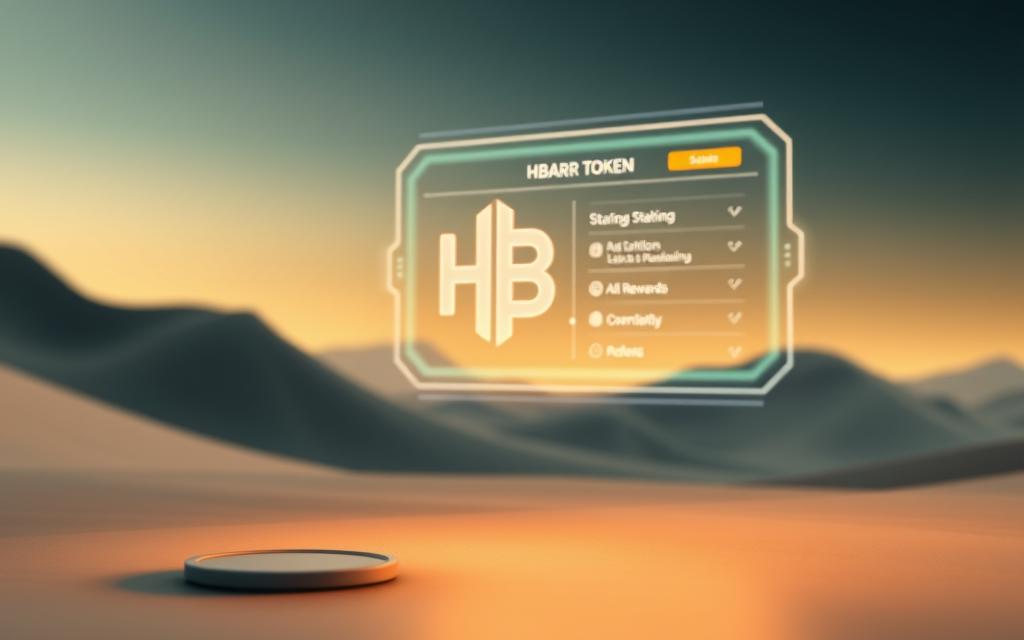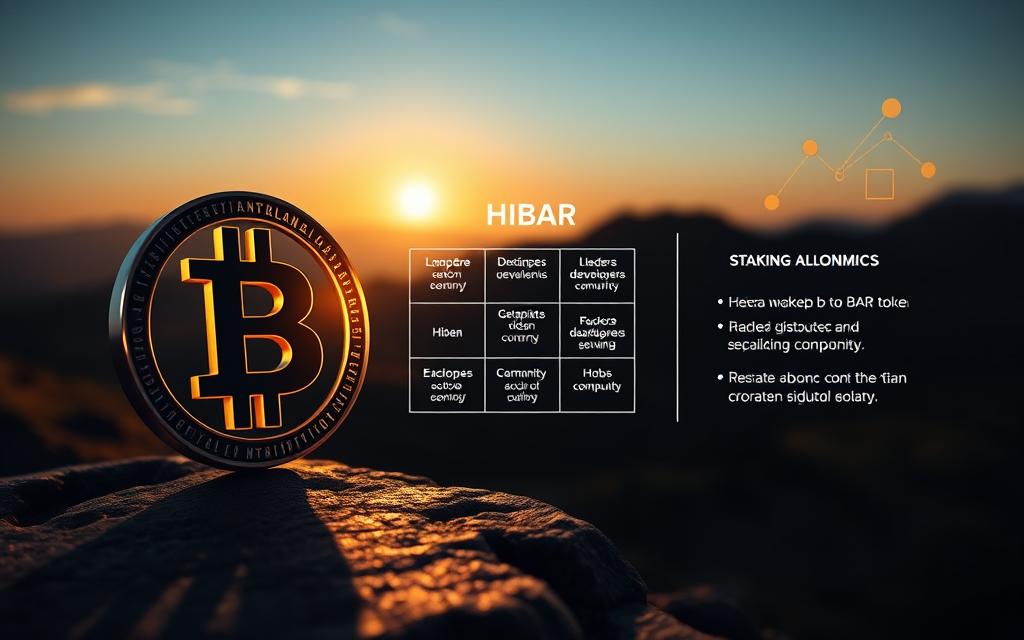Table of Contents
Hedera Hashgraph stands out as an enterprise-grade distributed ledger, offering high-speed transactions and low energy consumption. Unlike traditional blockchain networks, it leverages a unique consensus algorithm to achieve 10,000 transactions per second—far surpassing Bitcoin’s 7 TPS.
Backed by industry giants like Google and IBM, Hedera provides a secure platform for decentralized applications. Its native digital asset powers transactions, governance, and network security. With fees as low as $0.001 and near-instant finality, it’s built for real-world adoption.
The network’s eco-friendly proof-of-stake model consumes only 0.003 watt-hours per transaction. This positions it as a sustainable choice for businesses exploring blockchain solutions. From payments to supply chains, Hedera’s technology is gaining traction globally.
This guide covers the fundamentals, advantages, and growing use cases of this innovative platform. Whether you’re new to distributed ledgers or evaluating alternatives, understanding Hedera’s capabilities is essential.
Introduction to HBAR and Hedera Hashgraph
Developed by cryptography pioneer Dr. Leemon Baird, Hedera Hashgraph redefines distributed ledger efficiency. Alongside cybersecurity expert Mance Harmon, Baird launched the enterprise-grade network in 2017, offering a patented alternative to traditional blockchain systems.
The platform’s 39-member Governing Council—including corporations like Google and IBM—ensures decentralized governance. Members serve limited terms, preventing centralized control while maintaining regulatory compliance for institutional adoption.
Key milestones include the 2018 mainnet launch and subsequent smart contract upgrades. These advancements enable 10,000+ transactions per second, outpacing legacy networks. Currently, 42.2 billion HBAR tokens circulate from a fixed 50 billion supply, balancing liquidity and scarcity.
Unlike consumer-focused cryptos, Hedera prioritizes enterprise solutions. Strategic partnerships with Chainlink and LG integrate its technology into IoT ecosystems, showcasing real-world scalability.
What Is HBAR Crypto? Understanding the Basics
Powering the Hedera ecosystem, HBAR serves as both a transactional and governance asset. This native token enables fee payments, staking rewards, and decentralized decision-making. With 38 billion in circulation, it balances liquidity and scarcity.

Fees average $0.0001 per transaction—significantly lower than Ethereum or Bitcoin. “HBAR’s efficiency makes it ideal for microtransactions and enterprise-scale use,” notes a Hedera developer. The treasury holds 54.91% of tokens, ensuring controlled distribution until 2025.
Stakers earn up to 6.5% APY by securing the network. Node operators must meet specific requirements, fostering decentralization. Wrapped HBAR (WHBAR) bridges Hedera to DeFi platforms like Ethereum.
Unlike proof-of-work systems, Hedera’s model burns tokens periodically to enhance scarcity. This mechanism, combined with fixed supply, positions HBAR as a deflationary asset in the long term.
For storage, compatible wallets include Ledger and HashPack. Users benefit from instant finality and enterprise-grade security, key drivers for institutional adoption.
How HBAR Works: The Hashgraph Consensus Mechanism
Hedera’s breakthrough technology relies on a unique consensus mechanism called Hashgraph. It achieves lightning-fast transactions while minimizing energy consumption, making it ideal for enterprise use. Unlike blockchains, it uses directed acyclic graphs (DAGs) for efficiency.
Gossip Protocol and Virtual Voting
Nodes share data through a Gossip Protocol, spreading information like a rumor. Each node randomly selects peers to “gossip” with, ensuring rapid data dissemination. “This eliminates bottlenecks seen in traditional blockchains,” explains a Hedera whitepaper.
Virtual Voting then resolves conflicts without broadcasting every vote. Nodes compute consensus timestamps locally, reducing latency. This hybrid approach enables 10,000+ transactions per second.
Proof of Stake (PoS) Integration
Hedera’s proof of stake model secures the network while slashing energy use. Validators stake HBAR tokens to participate, with rewards up to 6.5% APY. Minimum staking requirements prevent spam attacks.
| Metric | Hedera (PoS) | Bitcoin (PoW) |
|---|---|---|
| Energy per Transaction | 0.003 WH | 2.9M WH |
| Carbon Impact | 99.9% Reduction | High |
Delegation simplifies staking for users. Platforms like HashPack allow token holders to delegate stakes without running nodes. Slashing penalties deter malicious actors, enhancing security.
“Hedera’s design ensures Sybil resistance—attackers can’t overwhelm the network without owning majority stakes.”
Partnerships with sustainability initiatives offset remaining emissions, making Hedera carbon-negative. This positions it as a leader in eco-friendly distributed ledgers.
The Hedera Network: Key Features and Services
Hedera’s network delivers enterprise-grade solutions through two powerful services. Designed for scalability, they support industries from finance to healthcare with 10,000+ transactions per second and fees as low as $0.0001. “These tools bridge the gap between blockchain potential and real-world adoption,” notes a Hedera partner.

Hedera Token Service (HTS)
HTS simplifies token creation for fungible and non-fungible assets. Companies like Airbus use it to authenticate supply chain parts, ensuring transparency. The service integrates seamlessly with existing applications, reducing development costs.
Key advantages include:
- Instant settlement for micropayments
- Regulatory compliance features
- Energy-efficient NFT minting
Hedera Consensus Service (HCS)
HCS provides a tamper-proof log for critical data, auditing 10M+ daily messages. Auditchain leverages it for real-time financial reporting. Copyright offices also use HCS to timestamp legal documents securely.
“Hedera’s consensus model offers unmatched integrity for sensitive records.”
Additional use cases span:
- Medical record verification
- IoT device communication
- Voting system security
For developers, Hedera’s architecture supports Solidity smart contracts, easing dApp creation. Its proof-of-stake ledger ensures sustainability while maintaining enterprise-grade throughput.
HBAR Tokenomics: Supply, Distribution, and Utility

HBAR’s economic model balances scarcity and utility with a fixed supply of 50 billion tokens. The network allocates 14.5% to SAFT investors, with the treasury holding the majority for ecosystem growth. Quarterly releases ensure controlled distribution until 2025, preventing market saturation.
Token burns enhance scarcity—1.4 billion HBAR were permanently removed this year. This deflationary mechanism, combined with a post-2025 inflation rate of 1.3%, positions HBAR as a long-term store of value. Early investor lockups further stabilize supply.
Staking rewards offer up to 6.5% APY, incentivizing users to secure the network. Over 90% of liquidity resides on major exchanges like Binance and Kraken, ensuring accessibility. For deeper insights, explore this tokenomics analysis.
The treasury funds grants and R&D, driving adoption. Unlike proof-of-work crypto assets, HBAR’s energy-efficient model aligns with sustainable finance trends. Its all-time high of $0.57 reflects growing investor confidence in Hedera’s governance framework.
Hedera’s Governing Council and Decentralization
Hedera’s governance model sets a new standard for enterprise blockchain organizations. The 39-member Governing council includes giants like Deutsche Telekom and Ubisoft, ensuring diverse industry representation. Members must meet strict criteria, including a $10M+ market cap, to prevent centralized control.

Decisions require supermajority approval, balancing efficiency with transparency. The “no single entity dominates” principle is enforced through term limits and rotating leadership. Nodes span 28 countries across multi-cloud infrastructure, enhancing resilience.
A 2025 roadmap will transition to permissionless nodes, further decentralizing the network. Quarterly audits and public reports validate adherence to anti-collusion measures. This framework supports scalable decentralized applications while maintaining regulatory compliance.
“Hedera’s council structure proves enterprises can collaborate without sacrificing decentralization.”
Unlike traditional blockchains, Hedera’s design prioritizes institutional trust. Its hybrid approach—combining council oversight with future open participation—positions it uniquely for mass adoption.
Real-World Use Cases for HBAR and Hedera
Micropayments under a penny? Hedera makes it possible with near-zero fees. Enterprises and developers harness its network for scalable solutions, from finance to IoT. Below are three sectors transformed by Hedera’s technology.
Decentralized Finance (DeFi)
Hedera’s speed supports transactions at 10,000 TPS, ideal for DeFi platforms. Stablecoin issuers use its low fees for cross-border settlements. “Traditional finance can’t match this efficiency,” notes a DeFi developer.
Key applications include:
- Instant loan approvals with smart contracts
- Staking pools offering 6.5% APY
- Wrapped HBAR bridging to Ethereum DeFi
Supply Chain Management
Global brands like Airbus track parts using Hedera’s tamper-proof ledger. Each item gets a unique timestamp, preventing fraud. The network’s energy efficiency aligns with ESG goals.
Notable implementations:
- Farm-to-table food traceability
- Pharmaceutical anti-counterfeiting
- Luxury goods authentication
Micropayments and IoT
AdsDax processes 500,000 daily micropayments—each under $0.001. EV charging stations use Hedera for pay-per-use models at 0.1¢ per kWh.
| Use Case | Volume | Fee per Transaction |
|---|---|---|
| Video streaming (VNBT) | 10M+ monthly | $0.0001 |
| Samsung 5G data | IoT device monetization | $0.00005 |
“Hedera’s micropayment tools unlock new revenue streams for content creators.”
Comparing HBAR to Other Cryptocurrencies
Enterprise adoption requires comparing critical blockchain parameters across leading networks. Hedera’s architecture delivers unique advantages against established technologies, particularly in transaction throughput and sustainability.
Finality occurs in 5 seconds—180x faster than Ethereum’s 15-minute average. This enables real-time settlement for enterprise applications. Network fees remain fixed at $0.0001 per transaction, undercutting Polygon’s $0.02 average.
Energy efficiency sets Hedera apart with just 0.003 watt-hours per transaction. Bitcoin consumes 2.9 million WH for equivalent transactions, making HBAR 99.9% more sustainable. The proof-of-stake model avoids the environmental costs of mining.
Smart contract compatibility differs across platforms:
- Hedera supports Solidity for Ethereum developers
- Solana requires Rust programming knowledge
- Cardano uses Haskell-based Plutus
Adoption metrics show 500+ enterprises building on Hedera versus 100 on Cardano. While Solana claims 65,000 TPS theoretically, Hedera’s 10,000 TPS operates consistently at mainnet scale. Market position reflects this balance—HBAR ranks #32 by capitalization among crypto assets.
“Hedera’s enterprise focus creates different value propositions than consumer-oriented blockchains.”
The network’s governance model and energy profile position it uniquely against top 10 coins. Institutional adoption continues growing as enterprises prioritize sustainable blockchain solutions.
Factors to Consider Before Investing in HBAR
Evaluating HBAR requires understanding its unique market position and technical fundamentals. While the network boasts enterprise adoption, investors must assess risks like centralization and price volatility. Current data shows HBAR trades 90% below its all-time high, with 24-hour swings averaging 8.3%.
Governance and Decentralization
The Governing Council’s oversight raises questions about true decentralization. Though 39 members rotate, critics argue this structure favors institutional players. “Permissioned nodes limit grassroots participation compared to fully open networks,” notes a blockchain researcher.
Key contrasts with competitors:
| Network | Node Access | Enterprise Backing |
|---|---|---|
| Hedera | Permissioned (until 2025) | Google, IBM, Deutsche Telekom |
| XRP | Open validators | Bank partnerships |
| ALGO | Permissionless | Academic/research focus |
Market Dynamics and Risks
HBAR’s price closely tracks enterprise crypto adoption trends. Federal rate hikes have dampened institutional interest, while tech stock correlations add volatility. Support sits at $0.05, with resistance near $0.08—key levels for trading strategies.
Macro factors influencing performance:
- Regulatory clarity for enterprise blockchains
- Energy costs impacting proof-of-stake networks
- Partnership announcements (e.g., LG, Chainlink)
“HBAR’s long-term value hinges on Hedera’s ability to balance decentralization with corporate needs.”
Where to Buy and Store HBAR
Securing HBAR requires choosing reliable platforms for trading and storage. Binance handles 50% of global volume, offering low fees and high liquidity. Alternatives like Kraken and Bybit provide robust security for U.S. investors.
Key exchange comparisons include:
- Binance: 0.1% spot fees, supports staking
- Kraken: 0.26% fees, strict KYC compliance
- Bybit: No withdrawal limits for verified users
Cold storage options like Ledger Nano X and D’CENT protect assets offline. These hardware wallets integrate with Hedera’s network, enabling secure staking. For mobile users, HashPack offers a step-by-step setup with biometric authentication.
The IRS classifies HBAR as property for tax purposes. Transactions exceeding $10,000 require reporting under U.S. regulations. Institutional buyers access OTC desks for bulk purchases without market impact.
“Enterprise clients prioritize custodial solutions that balance accessibility with audit trails.”
Always verify wallet compatibility and exchange reputations before transferring crypto. Hedera’s ecosystem supports seamless movement between trading platforms and self-custody options.
Conclusion
Enterprise leaders increasingly adopt Hedera Hashgraph for its unmatched efficiency. With 10,000 TPS and near-zero fees, the network outperforms legacy blockchains in speed and sustainability.
Partnerships with LG and Chainlink validate real-world utility. Investors benefit from 6.5% staking yields, though council governance remains a centralization concern.
For long-term holders, cold wallets like Ledger offer security. Traders can leverage volatility on Binance. Hedera’s eco-friendly design positions it as a top crypto choice for ESG-focused portfolios.
Next steps: Set up a HashPack wallet and explore staking options. The network’s growth trajectory makes early participation strategic.
FAQ
How does Hedera Hashgraph differ from blockchain?
Hedera Hashgraph uses a directed acyclic graph (DAG) structure instead of a traditional blockchain. This allows faster transactions, lower fees, and higher scalability while maintaining security through hashgraph consensus.
What makes the Hedera network energy-efficient?
Unlike proof-of-work blockchains, Hedera uses proof-of-stake (PoS) and a gossip protocol, reducing energy consumption significantly. The network processes thousands of transactions per second with minimal environmental impact.
Who governs the Hedera network?
The Hedera Governing Council, composed of global enterprises like Google, IBM, and Boeing, oversees protocol decisions. This ensures stability and enterprise-grade governance while maintaining decentralization.
Can developers build decentralized applications (dApps) on Hedera?
Yes. Hedera supports smart contracts and decentralized applications through its SDKs. Developers leverage its high-speed transaction processing and low fees for DeFi, identity management, and more.
What is HBAR’s role in the Hedera ecosystem?
HBAR, the native cryptocurrency, powers transactions, staking, and network services like Hedera Token Service (HTS) and file storage. It also incentivizes node operators to secure the network.
How does Hedera ensure fast transaction finality?
The hashgraph consensus mechanism achieves asynchronous Byzantine fault tolerance (aBFT), confirming transactions in 3-5 seconds. This outperforms many blockchains in speed and reliability.
What industries benefit most from Hedera’s technology?
Key use cases include supply chain tracking, micropayments for IoT devices, and decentralized finance (DeFi). Enterprises adopt Hedera for its auditability, scalability, and compliance features.
Where can I securely store HBAR tokens?
HBAR is supported by wallets like Ledger, Exodus, and HashPack. For large holdings, cold storage options or enterprise-grade custody solutions are recommended.









